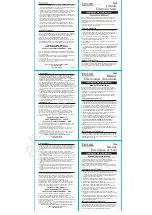
9
What You Should Know When Using This Unit
EN
Long-term planning for successful weight loss
Ignoring a balanced diet and simply reducing food intake to lose weight can lead to a decline in
muscle and bone. This may result in weight loss but not in the reduction in fat levels. So even
though your weight goes down, your resting metabolism is reduced making the body more
prone to putting on fat.
Repeated dieting and regaining weight leads to increased visceral fat levels
It is easy to regain weight after sudden diets. This regained weight tends to appear as visceral
fat rather then subcutaneous fat. Increased visceral fat levels are thought to increase the
likelihood of common diseases. Repeated dieting and subsequent regaining of weight leads to
increased visceral fat levels.
80
75
70
65
1
2
3
4
5
6
7
Weight
(Kg)
Months
Fat reduction:
3 kg
A starvation-like diet produces
rapid weight loss of 10 kg,
but disrupts body mass...
A healthy diet
with weight loss of 10 kg...
Lean body mass reduction
(muscle, bone etc.):
7 kg
Fat reduction:
9 kg
Lean body mass reduction
(muscle, bone etc.):
1 kg
Change in body fat percentage
Before diet:
After diet:
36.0%
36.9%
Body fat percentage
Lean body mass (muscle, bone etc.) is
greatly reduced, while the body fat
percentage has not changed.
Change in body fat percentage
Before diet:
After diet:
36.0%
28.3%
Body fat percentage
Body fat percentage reduced to a normal
level.
Example comparing the same loss of 10 kg
HBF500-E.book Page 9 Friday, October 24, 2008 10:41 AM










































